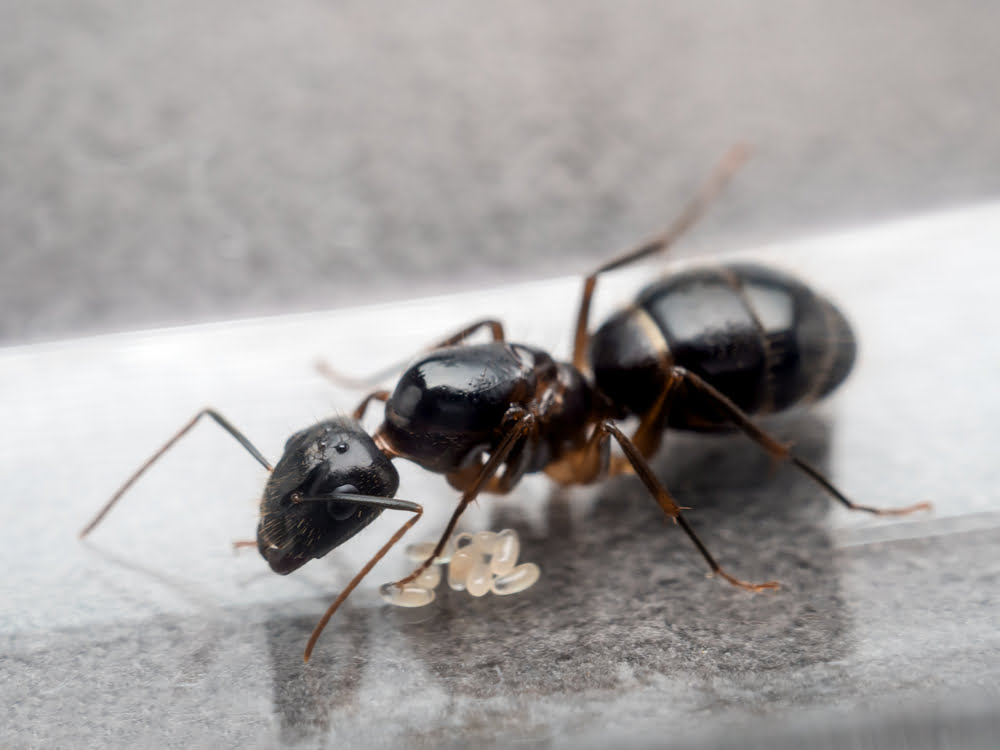Are you locked in battle with a colony of carpenter ants? You’re not alone—each year, hundreds of Québec home owners in the Greater Montréal area are forced to intervene to avoid serious damage to their home.
One ant is the root of the problem: the queen.
How do you find and kill the queen? How large is she? Is it possible to eliminate the queen without outside help? This article will answer your questions.
The importance of the queen in a colony
Any new colony of carpenter ants is founded by a single ant, placing it at the very top of the anthill’s hierarchy. Its title is well deserved, for the queen will lay all the eggs destined to become the thousands of ants forming the colony over a period of 3 to 6 years. The queen will also live longer than most of her offspring: her life expectancy is about 17 years, but can also stretch up to 30 years!
How to recognize the carpenter ant queen
A young queen that is ready to breed will grow wings. After having spent the winter in her colony of origin, in May the queen will leave it for good with one male (also winged), and will mate in flight.
The queen’s very well-developed abdomen already holds the ovaries which are ready to be fertilized; it also contains another compartment, the sperm pouch (or spermatheca), where the male’s sperm cells are stored. This reservoir can even keep the seminal fluid viable for several years, so that the queen can lay fertilized eggs without the need to mate again with a male.
The queen is the colony’s largest ant—measuring up to one inch long—and is mostly black with slight shades of brown or red depending on the species.
The carpenter ant queen’s characteristic behaviour
Once fertilized, the queen loses her wings and immediately begins seeking a suitable location to lay her first set of eggs. In nature, she will most likely choose a tree trunk, a large tree stump or piece of wood. The queen will feed her first offspring herself, over a period of 50 to 70 days, until they are able to take charge of feeding the next batches of ants that will be born after them.
Up to this point … no problem. We’re even impressed!
However, the main concern for us humans—who share the environment with these insects—is when the queen finds shelter in our homes, or nearby. What brings her to do this?
She has been attracted by two things: food and wood that is soft, damp, or decomposing.
Contrary to popular belief, carpenter ants don’t eat wood; they excavate it to form networks of galleries to store eggs and food. The queen will choose a spot that most fulfills these criteria. For example, in a home this might be wooden window frames, void spaces between walls, behind mouldings, stairs, “urethane” insulation or hollow doors.
Eliminating a carpenter ant queen: not so easy!
Some species of carpenter ants in Québec have only one queen, but other species can have several. What is true about all of them, however, is that the queen will only start laying reproductive female and male eggs at least 3 years after founding her own new colony.
Once the nest has become mature, part of the colony may at times break off to move nearby and establish a satellite colony, with no queen. This is why buildings can become severely infested over the years if left untreated.
All of this means that when eliminating a nest of carpenter ants, it’s important to try to locate the queen; the assistance of an experienced exterminator will save you a lot of time in this respect. Sometimes, it’s not always possible to find the queen amongst the thousands of ants present. If this is the case, it is likely that the nest in question is only a satellite nest and that the mother colony is elsewhere.
In many cases, the mother colony is located outdoors not far from your house, or near a neighbour’s house. In this situation, the recommended strategy is to ensure that the ants’ future access to your home is completely blocked; if the location of the mother colony outdoors can eventually be discovered, it is preferable to eliminate it. A pest control professional is able to inspect your home and its immediate surroundings, and will offer the best advice depending on the circumstances.
If you have reason to believe that a mother colony may have invaded the structure of your home, the help of a licensed exterminator will be invaluable to find it and eliminate it completely.

